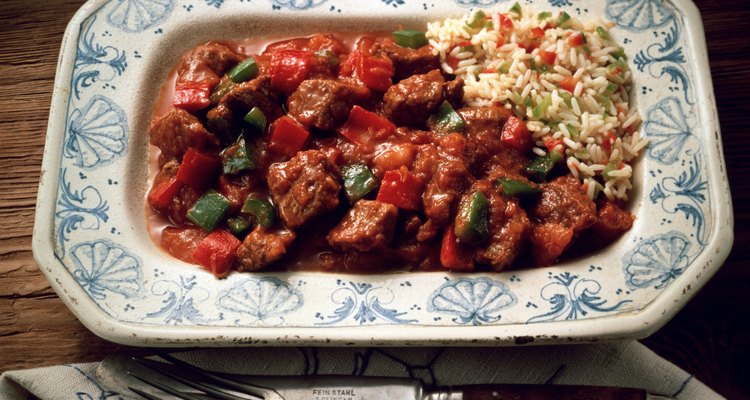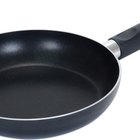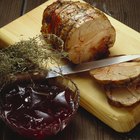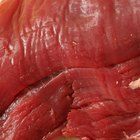
For any cook who's partial to a nice piece of beef, choosing the right cuts is an important part of the learning process. Beef ranges from meltingly tender to distressingly tough, depending which muscle it's cut from. For example, slow cooking makes beef shanks unusually rich and tender, but they're utterly inedible when they're cooked like a steak.
What Makes Cuts Tough
A modest understanding of beef anatomy is important for any cook. If you look at the beef-cuts chart at your local butcher shop, you'll see that the tenderest cuts usually come from the loin and rib sections. Those muscles are used mostly to hold the animal's skeleton in place, so they don't get a lot of exercise. The shanks are the exact opposite, seeing heavy use every time the steer stands up, lays down or takes a step. All that work makes the muscles dense and tough, and fills them with stringy, gristly connective tissue.
Cooking Like a Steak
If you look at a thick slice of shank, it appears at first glance to resemble a steak with a small piece of round bone in the middle. A closer inspection shows shiny streaks of a collagen, the connective tissue that makes up the ligaments in the muscle. It's the same as the chewy piece you find in a chicken drumstick, but much larger in a steer's leg. If you take that piece of shank and put it on your grill, it will sear to a beautiful brown on the outside and smell just as good as a steak. Unfortunately, it will be as tough as rawhide and you'll be lucky to slice it properly, let alone chew it.
Why It's Tough
Quick cooking is entirely the wrong approach for shanks. When you put a piece of beef on your grill, the proteins react to its intense heat by bonding together tightly and shrinking together. If you're cooking a T-bone or a New York strip, that won't matter because the meat is so tender to begin with. With a shank, your grill takes what's already one of the toughest pieces of beef and makes it tougher. That's not a recipe for success, and it's why shanks are typically slow-cooked instead.
Making it Tender
If you cooked those identical slices of shank for several hours in your slow cooker, or braised them in a pan in the oven, the result would be completely different. Under low, slow heat, the dense muscle fibers in the shank slowly begin to break down and soften. While that's happening, the tough connective tissues melt, changing from stringy collagen to moist, natural, richly flavored gelatin. Slow-cooked shanks take on a naturally soft and rich texture much like pulled pork, and create a flavorful broth in the process. This makes them ideal for slow-cooked winter meals, as well as soup- and stew-making.
Related Articles

How to Prepare Chuck Tender Roast

How to Cook Beef Top Round Pot Roast

What Is a Chateau Cut?

How to Tell the Grain of Meats
What is the Best Meat for Pot Roast?

What Is the Safe Cooking Temp for a ...

Low-Temperature Cooking of Baked Pork

How to Use an Electric Roaster to Slow ...

How to Make a Blackbuck Antelope Roast

What Are Pork Cutlets?

How to Grill a Lamb Steak

How to Use a Roaster Oven to Cook a ...

Can You Freeze Osso Bucco?

How to Barbecue Bologna on a Charcoal ...

How to Cook 5 Lbs. of Beef Tenderloin
How to Cook Buffalo Fillet

How to Cook Kobe Steaks
How to Slow Cook a Pot Roast With Beef ...

Can Beef Shoulder Roast Be Sliced and ...

How Do I Prepare a Hanging Tenderloin?
References
- On Food and Cooking: The Science and Lore of the Kitchen; Harold McGee
Writer Bio
Fred Decker is a trained chef and prolific freelance writer. In previous careers, he sold insurance and mutual funds, and was a longtime retailer. He was educated at Memorial University of Newfoundland and the Northern Alberta Institute of Technology. His articles have appeared on numerous home and garden sites including GoneOutdoors, TheNest and eHow.
Photo Credits
Eising/Photodisc/Getty Images